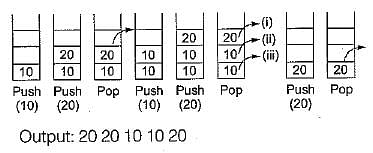Test: Arrays, Stack, Queues & Linked List- 2 - Computer Science Engineering (CSE) MCQ
15 Questions MCQ Test GATE Computer Science Engineering(CSE) 2025 Mock Test Series - Test: Arrays, Stack, Queues & Linked List- 2
The information about an array that is used in a program wiil be stored in
Which of the following expressions accesses the (i, j)th entry of a (m x n) matrix stored in column major form?
| 1 Crore+ students have signed up on EduRev. Have you? Download the App |
The postfix equivalent of the prefix * + ab - cd is
The postfix expression for the infix expression: A + B* (C + D) / F + D * E is:
In a circularly linked list organization, insertion of a record involves the modification of
Which of the following is useful in implementing quick sort?
The process of accessing data stored in tape is similar to manipulating data on a
Linked lists are not suitable for implementing
The following sequence of operations is performed on a stack,
PUSH(10), PUSH (20), POP, PUSH (10), PUSH (20), POP, POP, POP, PUSH(20), POP
The sequence of values popped out is
Which of the following operations is performed more efficiently by double linked list than by linear linked list?
The smallest element of an array’s index is called its
|
55 docs|215 tests
|
|
55 docs|215 tests
|




















